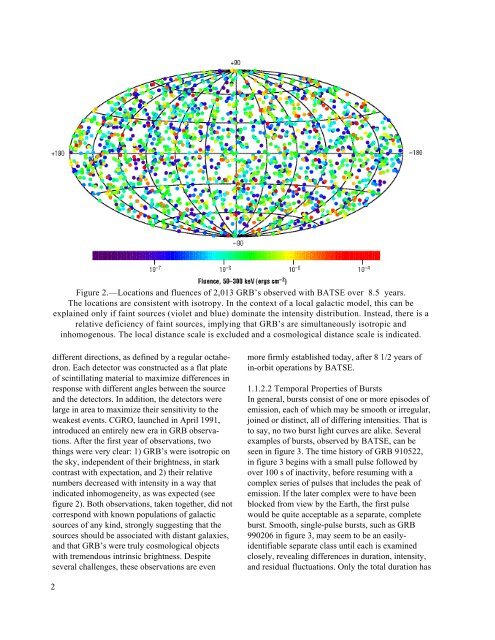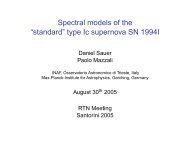Co-Investigator - The Gamma-Ray Astronomy Team - NASA
Co-Investigator - The Gamma-Ray Astronomy Team - NASA
Co-Investigator - The Gamma-Ray Astronomy Team - NASA
- No tags were found...
You also want an ePaper? Increase the reach of your titles
YUMPU automatically turns print PDFs into web optimized ePapers that Google loves.
Figure 2.—Locations and fluences of 2,013 GRB’s observed with BATSE over 8.5 years.<strong>The</strong> locations are consistent with isotropy. In the context of a local galactic model, this can beexplained only if faint sources (violet and blue) dominate the intensity distribution. Instead, there is arelative deficiency of faint sources, implying that GRB’s are simultaneously isotropic andinhomogenous. <strong>The</strong> local distance scale is excluded and a cosmological distance scale is indicated.different directions, as defined by a regular octahedron.Each detector was constructed as a flat plateof scintillating material to maximize differences inresponse with different angles between the sourceand the detectors. In addition, the detectors werelarge in area to maximize their sensitivity to theweakest events. CGRO, launched in April 1991,introduced an entirely new era in GRB observations.After the first year of observations, twothings were very clear: 1) GRB’s were isotropic onthe sky, independent of their brightness, in starkcontrast with expectation, and 2) their relativenumbers decreased with intensity in a way thatindicated inhomogeneity, as was expected (seefigure 2). Both observations, taken together, did notcorrespond with known populations of galacticsources of any kind, strongly suggesting that thesources should be associated with distant galaxies,and that GRB’s were truly cosmological objectswith tremendous intrinsic brightness. Despiteseveral challenges, these observations are evenmore firmly established today, after 8 1/2 years ofin-orbit operations by BATSE.1.1.2.2 Temporal Properties of BurstsIn general, bursts consist of one or more episodes ofemission, each of which may be smooth or irregular,joined or distinct, all of differing intensities. That isto say, no two burst light curves are alike. Severalexamples of bursts, observed by BATSE, can beseen in figure 3. <strong>The</strong> time history of GRB 910522,in figure 3 begins with a small pulse followed byover 100 s of inactivity, before resuming with acomplex series of pulses that includes the peak ofemission. If the later complex were to have beenblocked from view by the Earth, the first pulsewould be quite acceptable as a separate, completeburst. Smooth, single-pulse bursts, such as GRB990206 in figure 3, may seem to be an easilyidentifiableseparate class until each is examinedclosely, revealing differences in duration, intensity,and residual fluctuations. Only the total duration has2



